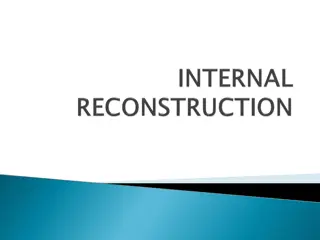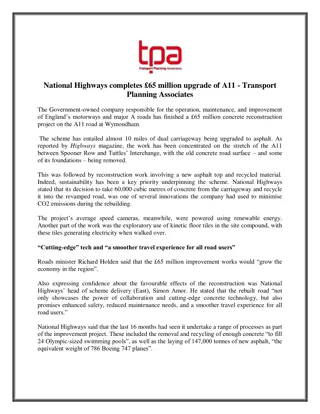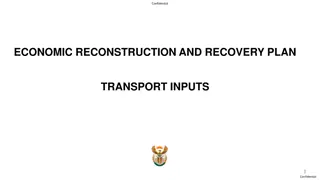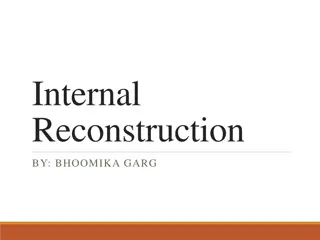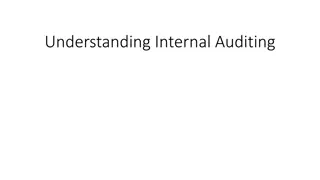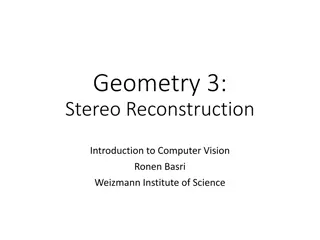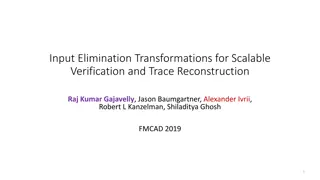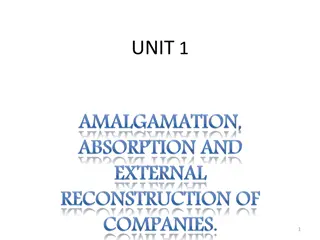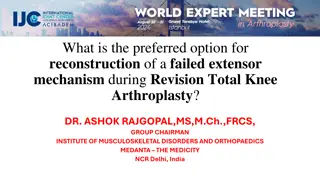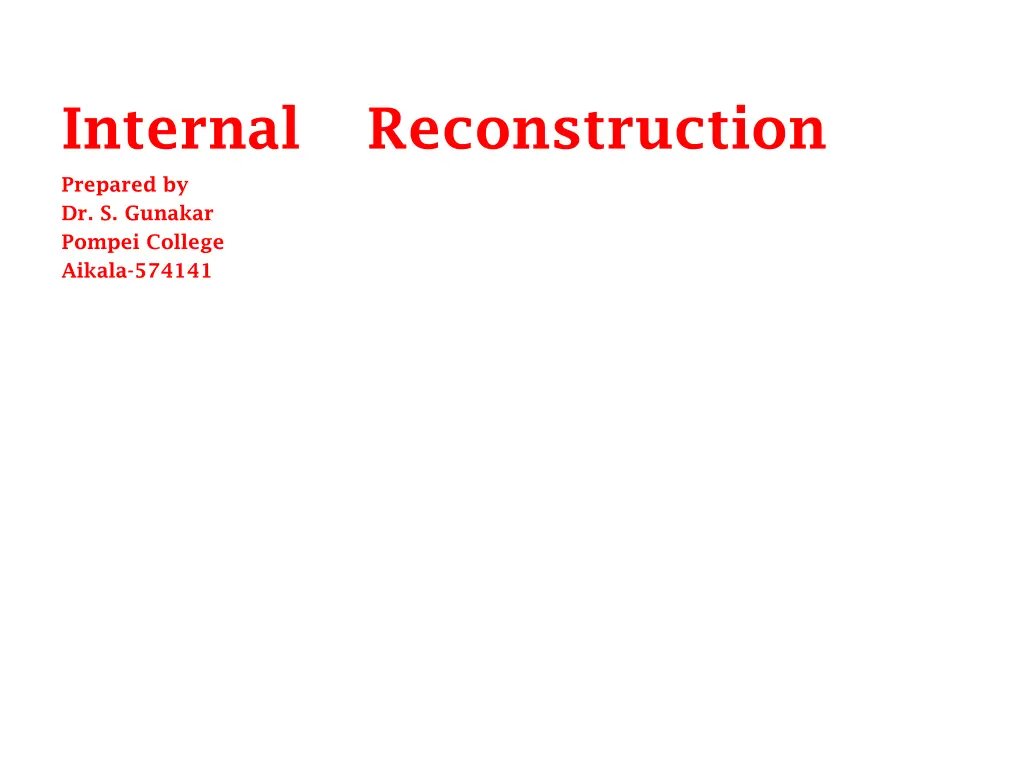
Understanding Internal Reconstruction in Accounting
Internal reconstruction in accounting refers to the process where a company alters its capital structure and liabilities internally to address financial challenges without going into liquidation. This involves reorganizing or altering share capital and reducing liabilities. By understanding the conceptual framework and procedures involved, companies can effectively navigate through financial difficulties and present a true and fair view of their financial position.
Download Presentation

Please find below an Image/Link to download the presentation.
The content on the website is provided AS IS for your information and personal use only. It may not be sold, licensed, or shared on other websites without obtaining consent from the author. If you encounter any issues during the download, it is possible that the publisher has removed the file from their server.
You are allowed to download the files provided on this website for personal or commercial use, subject to the condition that they are used lawfully. All files are the property of their respective owners.
The content on the website is provided AS IS for your information and personal use only. It may not be sold, licensed, or shared on other websites without obtaining consent from the author.
E N D
Presentation Transcript
Internal Reconstruction Prepared by Dr. S. Gunakar Pompei College Aikala-574141
Learning Objectives To understand the conceptual Framework To Know the accounting procedure To familiarize with the Problems connected thereto
Conceptual Framework A company might have suffered huge losses in the past or might have the problem of over capitalization or might have over valued its fixed assets because of inadequate provision for depreciation. Such a company faces the danger of going onto liquidation either voluntarily or because of a petition by any of its creditors or Debenture holders. In these circumstances companies have three options: 1. To Liquidate the company (Liquidation) 2. To Reconstruct Externally ( External Reconstruction ) 3. To Reconstruct Internally ( Internal Reconstruction)
Meaning Internal Reconstruction is an arrangement made by companies whereby the claims of shareholders, Debenture holders, creditors and other liabilities are altered/reduced, so that the accumulated losses are written off, assets are valued at its fair value and the balance sheet shows the true and fair view of the financial position. It is an arrangement under which a company, instead of going into liquidation, internally by merely altering or reducing the capital of its shareholders and the claims of its debenture holders and creditors with their consent. reconstructs itself
Forms of Internal Reconstruction Internal Reconstruction may take any of the following two forms: 1. Re-organization or Alteration of Share Capital 2. Reduction of Share Capital and other Liabilities
I. Re-organization or Alteration of Share Capital (Sec. 94-97) Re-organization or alteration of share capital refers to the re- arrangement of the capital of the company and include the following: a. Increasing the share capital by making fresh issue of shares b. Decreasing the share capital by cancelling the unissued shares. c. Conversion of shares into stock and vice versa d. Consolidation of shares of smaller amounts into shares of larger amounts e. Sub-division of shares of larger amounts into share of smaller amounts. A company can alter its share capital if it is authorized by its Articles of Association by passing an ordinary resolution in the general meeting. Confirmation of the court is not required.
II. Reduction of Share Capital and other Liabilities (Sec 100-105) Reduction of Share Capital is an arrangement under which the capital of the shareholder and sometimes even the claims of debenture holders and the creditors are reduced. The amount made available by capital reduction is utilized in writing off the accumulated losses, fictitious overvalued portion of the other assets. A company can reduce its paid-up capital if a. It is authorized by its articles b. A special resolution is passed and c. A sanction of the court is obtained assets and the
Differences between Internal Reconstruction and External Reconstruction a. No new company is formed in case of Internal Reconstruction. A new company is formed in case of External Reconstruction. b. In case of Internal Reconstruction, no company is liquidated. In case of External Reconstruction one company is liquidated c. Internal Reconstruction requires court s confirmation. But External Reconstruction can confirmation d. Internal Reconstruction is a slow and tedious process. But External Reconstruction can be carried out easily e. In the case of Internal Reconstruction, the company is able to set off its past losses against future profits. Whereas, in the case of External Reconstruction, the past losses of the old company can t be set off against the future profits of the new company. be effected without court s
Accounting Procedures: Journal Entries ( Reorganization/Alteration of capital) 1. Increase of share capital by issue of fresh shares Bank A/c Dr. To Share Capital A/c 2. Decrease of share capital by cancellation of unissued shares No Entry 3. Conversion of shares into stocks Shares capital A/c Dr. To Stock A/c
4. Reconversion of stocks into shares StockA/c Dr. To Share capitalA/c 5. Consolidation of shares of shares of smaller value into shares of higher value Share capital A/c ( Smaller value) Dr. To Share capital A/c ( Higher value) 6. Sub-division of shares of higher value into shares of smaller value Share capital A/c ( Higher value) Dr. To Share capital A/c ( Smaller value)
Journal entries (Reduction of capital) 1. Reducing the liability on partly-paid shares( Here paid up capital is not affected, but the partly paid up shares became fully paid up shares) Share capital (Partly-paid up)A/c Dr. To Share capital (Fully paid )A/c 2. Paying off paid-up capital which is in excess of the need of the company. a) For transferring extra capital to shareholders Share capitalA/c Dr. To Shareholders A/c b)For paying ShareholdersA/c Dr. To Bank/cashA/c
3. When the face value of share is changed or the rate of dividend on Preference share is changed (Old) Share capital A/c Dr. To Share capital A/c (New) To Capital reduction A/c or (Reconstruction A/c) (Balancing figure) 4. If any paid up share capital is reduced without reducing face value of the shares For e.g: shares of Rs. 100 each on which Rs. 80 paid reduced to shares of Rs. 100 each, Rs. 60 paid up. Share capital A/c Dr. To Capital reduction A/c
5. If any sacrifice has been made by the creditors and Debenture holders: Creditors/Debenture holders A/c Dr. (with amt. of Sacrifice) To Capital Reduction A/c 6. If the value of any asset is appreciated Respective Asset A/c Dr. To Capital Reduction A/c 7. If there are reconstruction expenses Capital reduction A/c Dr. To Reconstruction Expenses A/c
8. Where any contingent liability ( say sales tax) arises and is to be paid immediately. The following entry will be passed. a. Capital reduction A/c Dr. To Liabilities payable (Sales Tax) A/c b. Liabilities payable A/c (Sales Tax) Dr. To BankA/c 9. If the old share Capital is surrendered altogether and new shares are issued a. For transfer of old share capital to capital reduction account Old share capital A/c Dr. To Surrendered shares A/c b. For issuing new shares from surrendered shares Surrendered Shares a/c Dr. New Share Capital A/c c. Balance in surrendered shares must be transferred to Capital Reduction account
10. If there is over-valuation of some assets (i. e if depreciation on some assets is to be provided for ) Capital Reduction A/c Dr. To Asset A/c 11. When amount of capital reduction is utilized for writing off fictitious assets, past losses and excess value of other assets: Capital reduction /Reconstruction A/c Dr. To Profit and Loss account (loss) To Preliminary Expenses To Discount of issue of shares or debentures account To underwriting commission account To Advertising Suspense s account To Reconstruction Expenses account To Good will account To Patents or Trade Marks account To Fixed assets account (over valued assets) To Other assets account To Capital Reserves account (if some balance is still left)
Other Points to be remembered: 1. If there are any reserves on liabilities side of the Balance sheet they may be used for writing off the losses and fictitious assets. 2. No entry need be passed for the cancellation of any contingent liability, such as arrears of dividend on Preference shares. 3. The words And reduced have to written after the name of the reconstructed company only when court and not invariably be it is required by the


